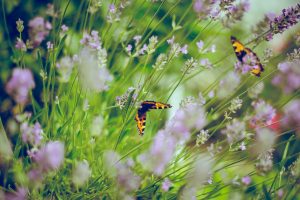It’s true, the month of January, with its cold weather and snowfall, doesn’t exactly scream gardening, but there are actually plenty of things you can be doing this time of year to make the most out of your gardening season. There’s a quote that we love from author, Josephine Nuese that goes:
“Anyone who thinks gardening begins in the spring and ends in the fall is missing the best part of the whole year: For gardening begins in January with a dream.”
We couldn’t agree more!
January is for dreaming & designing, pondering & planning, so that come springtime, you are ready to hit the ground running. There are also a few things around your Utah garden you should be keeping an eye on, so here are some garden tips & ideas to keep you busy this month:
Watch for Heavy Snow Loads 
Make sure to keep heavy snow loads brushed off of your shrubs and small trees to prevent breakage. Gently brush the snow off by hand or with a broom. Don’t shake the branches, as they are likely brittle this time of year. In the case of ice, let it melt, instead of trying to remove it.
To prevent ice and snow build-up, you can wrap your trees or shrubs with twine to keep multiple leaders together.
Stay Off Dormant Frozen Lawns
If you can, stay off your frozen lawn in order to protect the plant crowns from breakage. When the lawn appears frosted, the blades of grass are frozen and walking or mowing will cause damage that will make it so your lawn won’t be able to bounce back quickly in spring. This could cause more work for you.
 Check On Your Bulbs
Check On Your Bulbs
Check on your stored bulbs such as begonias, cannas, and callas a few times throughout the winter to make sure that they are still firm. Throw out any bulb that is mushy or moldy to prevent them from ruining the whole bunch. If it’s just a small mushy patch, you may be able to salvage the bulb by removing the spot with a sterilized knife.
If you notice that the bulbs are getting too dry, you may need to moisten the storage medium with a mist of water.
Start Dreaming
This is the really exciting part. Start thinking about everything you want to grow in your garden, and how you want it to look. Read through catalogs for plants and ideas you may want to incorporate into your planting beds. Order seeds or plugs early if they need to be started early indoors, and to get the best selection! A fantastic way to keep track of all of your ideas is with a garden journal.
What is a garden journal? 
Every garden & gardener is unique and so every garden journal is unique as well. A garden journal can be anything you want it to be. You can use anything from a regular notebook, your computer, or a planner, to a commercially made garden journal.
Here’s a local Utah notebook designer company that we love! Not only can you support local artists, but your purchase will also help to build schools. That’s a win-win.
The point of the journal is to plan ahead, keep track of what you are growing, and note what went right and what went wrong. From year to year, you’ll be able to look back at your journals, celebrate your successes, and learn from your challenges.
How Do I start?
Like we said before, there’s no right or wrong way to keep a garden journal. Each is unique to the gardener. But whether you have a small vegetable garden or are landscaping a large property, there are a few basic things you can keep track of in your journal.
A great way to start is to log your plant hardiness zone, which is the standard gardeners can use to figure out what plants thrive best in their zone. Our garden center in Utah is a zone 6, even though the USDA map has us listed as a zone 7a. The wild weather here in Utah creates a lot of microclimates that can be tricky to ascertain. Some local resources with a bit more guidance about many microclimates in Utah are Conservation Garden Park and USU Extension Services, both are excellent resources for Utah gardeners.
Another important thing to keep track of would be your average spring and fall frost dates.
It helps to split your garden journal into different sections, which could include: planning, sketches, seeds & plants, a calendar, a growth log, expenses, maintenance, etc. Organize your journal to suit your needs and your garden.
Setting up your garden journal is a great way to keep yourself busy while you wait for spring. When it comes to planning, we’d be happy to have you come into Glover Nursery where you can talk to one of our knowledgeable specialists about preparing your garden. You can also schedule a landscaping consultation here.

